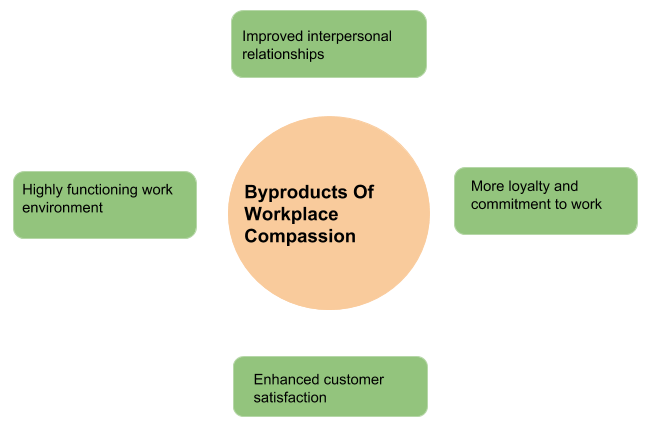Compassion in the Workplace: 9+ Examples & Tips for Leaders
 Compassion comes from a Latin word that means “co-suffering.”
Compassion comes from a Latin word that means “co-suffering.”
Compassion has always secured a firm place in almost all religious practices.
The Dalai Lama, one of the most respected Buddhist teachers, stated that individual acts of compassion and kindness have the power to spread harmony in the entire world.
In psychology, compassion is regarded more like action rather than an emotion. Involving elements of empathy, love, and care, compassionate expressions aim at alleviating the troubles of others or sharing them with the sufferer.
This piece investigates the professional benefits of being compassionate – how being compassionate can help your career grow and how many successful leaders today rely on compassionate leadership to flourish in their field. Let’s dive in.
Before you continue, we thought you might like to download our three Positive Relationships Exercises for free. These detailed, science-based exercises will help you or your clients build healthy, life-enriching relationships.
This Article Contains:
What Is Compassion in the Workplace?
Before we begin, let’s first recap what compassion is.
Compassion has three components:
- We must feel that the troubles evoking our feelings are serious.
- We require that the sufferer’s troubles are the result of unfortunate circumstances. That is, they are not self-inflicted.
- We must be able to picture ourselves in the same predicament (Cassell, 2002).
Compassion doesn’t follow a give-and-take approach. Instead, it has an added component of altruism in it as the person showing compassion rarely expects to receive the same or does so to get something in return. In all its essence, compassion is “empathy in action.”
Recent research and findings have recognized compassion to be an essential aspect of a productive work environment (Dutton, Workman, & Hardin, 2014). Showing compassion to colleagues is vital to sustaining job satisfaction and work-related motivation.
Compassion in organizations
Organizations where compassion prevails, have employees with reduced stress and more job satisfaction (Fineman, 2000). Additionally, workplace compassion also invites more loyalty, dedication, and employee engagement.
Organizations have an emotional component, and employees who work with each other compassionately are more likely to help and cooperate with each other.
We can express compassion in the workplace by:
- Noticing when colleagues are in pain or are undergoing some personal stressors and trying to make them feel secure and comfortable at work,
- Actively listening to others without judging them,
- Accepting criticisms and carefully stating our opinions to someone for underperformance or failure, making sure we don’t hurt their feelings.
Focusing on compassion at work promotes healthy interpersonal relationships (Dutton & Ragins, 2007). It lets us acknowledge and appreciate others wholeheartedly and work for the organizational benefits, rather than personal gains. Compassion works by building trust, mutual connections, and reciprocation.
Acts of kindness in the workplace impact not only the carer and the receiver, but it also afects the performance culture as a whole (Brody, 1992).
It reduces anxiety, the pressure of achieving, and makes them resilient to work stress and burnout (Frost, Dutton, Worline, & Wilson, 2000). And this is why many leading organizations today emphasize building a compassionate environment before aiming for any other achievements.
A Look at the Importance and Benefits

Organizations may have tremendously talented professionals who have uber experience in their field, but unless they greet others with respect, talk empathetically, or internalize others’ pain, they cannot be as successful in their fields.
The benefits of being compassionate at work are vast. It facilitates a healthy flow of communication that has warmth and love in it and goes all the way to improve a company’s organizational health.
1. Employee retention
One of the vital benefits of a compassionate workplace is employee retention. Employees who receive empathy, understanding and help from their colleagues and superiors are likely to stay in the organization for a long period of time and install all their efforts for the benefit of the organization (Van Bommel, 2021).
On the contrary, employees who are ill-treated or fail to receive any professional co-operation whatsoever will lose motivation to work productively (Porath, 2016).
2. Stress reduction
Compassion creates space for active communication. Employees in a compassionate work atmosphere can vent their professional troubles to each other and socialize in the office.
Working with compassionate and kind people gives employees the chance to manage work stress and burnout and use their emotional resources to combat it (Figley, 1995; Lilius, Worline, Dutton, Kanov, & Maitlis, 2011).
When people exchange positivity and bond with each other at work, their stress level significantly reduces (Ozaki, Motohashi, Kaneko, & Fujita, 2012).
3. Physical wellbeing
Heaphy and Dutton (2008) revealed that employees who spent a few minutes interacting and mixing with their colleagues had steady blood pressure and heart rate (Heaphy & Dutton, 2008).
What’s more, their immune systems were well functioning, making them less prone to take sick leave. Increased functioning also called for better work-life balance, and the employees had happier families and social life.
4. Interpersonal bonds
It has been said that leaders and managers who follow compassionate approaches at work, have highly reciprocating employees who work dedicatedly for the company. Employees tend to pay forward the goodness they receive at work by achieving the organizational targets.
In addition, employees also form healthy and strong professional relationships and feel comfortable to work as a part of the team.
Exchanging compassion promotes generosity and builds affective commitment of the workers towards their superiors and the institution as a whole (Shanock & Eisenberger, 2006).
When people perceive that they are valued and cared for by the organization, they automatically feel positive about their work commitments and voluntarily offer support and care to others they work with (Fowler & Christakis, 2010; Goetz, Keltner, & Simon-Thomas, 2010).
Research and Studies

Spending such a long time in a place where we do not receive or get the chance to express compassion can take a toll on our mental health and wellbeing.
For example, a person who is undergoing marital separation and is suffering from significant emotional distress can very quickly lose focus while working in a cruel environment. But on the flip side, if that person receives attention, help, and support from colleagues during such difficult times, it may work wonders in rebuilding self-esteem and keeping productivity untouched (Folkman 1997; Folkman & Moskowitz, 2000).
Compassion from leaders and co-workers brings a feeling of gratitude and influences the person to reciprocate in the same way when noticing someone else struggling with adversities (Fredrickson, 2003; Fredrickson, Tugade, Waugh, & Larkin, 2003).
In a hospital-based survey on the importance of compassion and empathy at work (Meyer & Allen, 1991), it was found that being treated with kindness created a positive emotional attachment for employees towards their work and patients towards their medical careers.
Compassion and care are traits all medical professionals should portray, and the investigators chose a hospital setting for the research assuming that they would have no barriers in openly discussing compassionate working.
Objective scales for measuring positive emotions, the frequency of compassion, and compassion satisfaction showed that employees who had better scores in the compassion and positivity scales had more likeability among patients and fellow workers (Tsui, Pearce, Porter, & Tripoli, 1997).
The large-scale investigation firmly asserted the role compassion has in building affective commitment and reducing the professional strain that comes from working in such a demanding profession (Allen, 2001).
Michael West: compassionate and inclusive leadership – The King’s Fund
What Does Compassion in Organizations Look Like?
Thupten Jinpa, a Tibetan scholar and English translator to the Dalai Lama, defined compassion as “a mental state endowed with a sense of concern for the suffering of others and aspiration to see that suffering relieved” (Tan, 2012).
Jinpa indicated that every expression of compassion has three aspects in it (Tan, 2012):
- The cognitive aspect – “I understand your problems”
- The affective component – “I feel what you feel”
- The drive or motivational component – “I want to help you out of this.”
Compassion in organizations means:
1. More importance on employees’ wellbeing
People who are more compassionate and considerate toward their employees on a one-on-one level are more popular and successful in their careers (Melwani, Mueller, & Overbeck, 2012).
For instance, if a recruit suddenly encounters a personal loss, a compassionate working system would allow the recruit time off and offer support to overcome the adversity and bounce back positively, rather than pressurizing the recruit with protocols and formalities.
Not only would this compassion help the recruit recuperate, but it will also bridge the gap in the leader-employee relationship and give it a mutually beneficial turn.
2. More positive relationships flowing at the workplace
Compassion encourages employees to have more positive contact with each other. Compassionate leaders and managers can build this attitude by organizing weekly meetups or feedback sessions, or allocate more group projects so that the employees get a chance to work in the team spirit, get the motivation to help and support each other, and contribute to the common goal of the company.
3. More open-hearted interactions
Nonjudgmental heart-to-heart conversations at the workplace call for more authenticity and openness among co-workers. In an empathetic work environment, leaders and co-workers treat each other with respect irrespective of what designations they hold. They are always up for discussions and are ready to attend to any issues that might require their assistance.
4. Wider perspective
Compassion in organizations invites ‘cognitive empathy’ or the feeling of ‘this person is just like me.’ Managers and workers in a compassionate environment are always aware and ready to accept the perspective of others, and try to step into their shoes before concluding.
Such an approach builds an overall broad understanding of the industry and automatically gets passed on as a part of the performance culture among all employees of the firm.
5. More self-compassion
It is vital to be self-compassionate before we can accept or express compassion to others. Unless we are kind to ourselves, we can never understand the value of compassion and how it benefits us.
Self-compassion is easy to practice. We can start with daily positive self-affirmations like “I am worth it,” “I am free from sorrow, pain, and guilt,” “I am trying my best,” etc., and slowly pass on the same values in our interpersonal relationships at work.
When the relationship you have with yourself is characterized by balance, compassion, and acceptance, it sets the tone for your relationship with others, including coworkers and the people you lead.
To learn more about creating a kinder and more nurturing relationship with yourself, check out our 17 Self-Compassion Exercises and the following blog posts:
15 Most Interesting Self-Compassion Research Findings
How to Practice Self-Compassion: 8 Techniques and Tips
What Is Mindful Self-Compassion? (Incl. Exercises + PDF)
As the 14th Dalai Lama, known as Gyalwa Rinpoche, once said,
We can never obtain peace in the outer world until we make peace with ourselves.
The inner peace this quote illustrates regards the concept of self-compassion.
Self-compassion consists of three distinct constructs (Hollis-Walker & Colosimo, 2011):
- showing ourselves warmth and kindness rather than harsh self-criticism or judgment,
- accepting that imperfection, failure, and suffering is an unavoidable part of the human condition,
- mindfully paying attention to one’s suffering in the present moment with clarity and balance.
The techniques mentioned here can be implemented to start or develop your journey to self-compassion. Don’t put too much pressure on yourself, and remember that it is also completely normal to feel self-doubt or insecurity.
Just because you experience these emotions sometimes do not mean that you cannot implement small methods of self-compassion into your daily routine. Keep in mind that showing self-compassion is not selfish or narcissistic, just the contrary.
6 Tips on How to Show Compassion at Work

1. Self-compassion
All positive feelings should start with yourself. Unless you can show love and kindness to you as a person, you cannot prove it to anyone else. Start with regular activities such as giving a few compliments to yourself, forgiving yourself for any past mistakes, and focusing on your strengths and capabilities more than your shortcomings.
2. Communication
The key to being compassionate work is a sound communication pattern. Whether it is with a team member, supervisor, or client, communicate openly and express yourself clearly to others. At the same time, lend your ears to anyone who wants to confide in you and listen with patience and neutrality at all times.
3. Contact
If it is appropriate to do so, express your compassion by establishing gentle physical contact with the other person. A gentle pat on the back, eye contact, or holding hands while listening to shared sorrows are powerful nonverbal cues that express compassion and empathy.
4. Encouragement
Compassion gets reflected by verbal encouragement and motivation. You can practice compassion at the workplace by continuously supporting and cheering others for their hard work and achievements. You may never know when your words will start reinforcing them positively and bring about favorable changes, but keep on encouraging them.
5. Initiation
Whether it is by providing personal support, exchanging feedbacks, or expressing your opinions, if you are a compassionate worker, be prepared to take the first move. Compassionate leaders and workers set an example for the entire workplace with their sense of responsibility and openness to others.
6. Thoughtfulness
Be aware of the emotions and thoughts of others. How your words might affect your colleagues, subordinates or clients should be your prime concern. You can work on building general awareness by careful observation at the workplace, organizing meetings and feedback sessions at regular intervals, or one-on-one conversations that can help gauge the mental state and level of engagement in the person.
What Is Compassionate Leadership? (Incl. Definition)

In his works, Zinn indicated compassionate leadership as a way to reduce work stress and increase peace among professionals.
His studies further suggested that compassionate leadership is a learned phenomenon, and anyone is capable of building themselves up as a compassionate professional if they want to.
Following this line of research, the Harvard Business Review created an assessment to help leaders identify their levels of compassion. The evaluation is self-scorable and gives an accurate judgment of whether or not we can call ourselves compassionate leaders. You can take the test here.
A compassionate leader is interested not only in motivating employees to gain profits for the company, but also helping them grow on a personal level. Such leaders have the far-sighted vision to hold genuine talents for long-term and think about the greater good of the organization.
It is obvious that compassionate leaders are preferred more among employees, more popular among clients, more comfortable to talk to, and more positive in giving honest feedback.
The Compassionate Leadership Model
Roffey Park’s Compassion Workplace Model states that there are five aspects of compassionate leadership and management (Poorkavoos, 2016):
- Being aware of the needs of others.
- Being non-judgmental to the viewpoints of others.
- Being resilient and tolerant toward personal distress.
- Feeling and showing empathy at all levels of a professional life.
- Being accountable and responsible for all good and bad outcomes of the team.
The compassionate leadership model emphasizes the here and now aspect of leadership. That compassionate leader should be mindful of the present situation, and the current requirements of the organizations is a vital requisite here.
How to best demonstrate compassion as a leader
Emotions and mental wellbeing can influence our productivity at work. By helping more compassionate leaders grow in the organization, we can directly foster advancement and help distressed employees to get back their efficacy.
Although compassion is an innate human trait and people differ in the way they choose to show kindness to others, here are some ideas for demonstrating compassion as a leader:
1. Slow down when you need to
Even though there are a multitude of tasks to be accomplished within the day, it is vital for leaders to pause at times and breathe. By slowing down and observing what is going on, leaders can gain mindfulness of their teams and the work ambiance as a whole.
Pausing for a while makes it easier to sense any tensions that may be affecting the organization and deploy measures accordingly.
2. Never stop asking
A compassionate leader never refrains from asking questions or getting feedback. To them, communicating and learning about the perspective of others is a way to get closer to them and help in removing any obstacles in the path of success.
3. Empathize every day
Acknowledging others’ problems as if they were your own is a quality that makes compassionate leaders stand out among others. There are times when empathizing may make the leader overwhelmed, experience compassion fatigue, or stressed out. However, in most cases, they find that understanding other’s problems is the best way to stay firmly attached to the team as a whole.
4. Be open to change
Compassion is synonymous to action and dedication. Leaders who work with an open mind realize the power that small changes in daily routine can bring in overall productivity. Compassionate leaders are ever ready to tweak their lifestyle, change their leadership policies, and embrace new strategies that might benefit the organization.
If you identify yourself as a compassionate leader, try challenging yourself as often as you want to and push your boundaries. You may never realize your potential unless you decide to get out of your comfort zone. Remember that compassionate leadership is all about:
- The ability to lead as a person others would love to follow.
- The quality of inspiring others and creating a futuristic vision for the company.
- Making team members feel valued and appreciated.
- Inspiring others by setting the right examples.
- Building a conducive work environment with high performance culture and mutually beneficial professional commitments.
- Caring for and treating others with kindness and affection.
4 Recommended Books
1. Compassion Inc.: Unleashing the power of empathy in life and business – Gaurav Sinha

His findings in the field of compassionate leadership and ethical working styles are phenomenal and consider all the little aspects of consumerism, altruistic leadership, business principles, and the transformation of unique selling proposition (USP) to universally sustainable principles (USPs).
As many readers would agree, this book is one of the best reads if you are looking for a positive shift in your business.
Find the book on Amazon.
2. Awakening Compassion at Work – Monica Worline and Jane Dutton

This book identifies how a lack of kindness can exhaust workers and deplete their motivation and team spirit.
By outlining practical steps for alleviating suffering and distress at work by using compassion, this book has a powerful message to convey to all leaders and personnel who want to work on their compassion skills in the workplace.
Find the book on Amazon.
3. The Compassion Achiever: How Helping Others Fuels Success – Dr. Christopher Kukk

Covering the health and psychological benefits of working in a compassionate environment, Dr. Kukk makes this book a great resource for professionals and supervisors of all professional fields.
Find the book on Amazon.
4. Self-Compassion: The Proven Power Of Being Kind To Yourself – Dr. Kristin Neff

She discusses the way constant work pressure and the demanding nature of our professional lives can take a toll on our overall wellbeing, and collectively impact our productivity at work.
Neff says that unless we start showing compassion to ourselves and keep our wellbeing at the top of the priority list, we can never succeed as a compassionate leader or employee. The book is a one-stop guide to holistic happiness and self-love and is highly recommended for professionals at all levels.
Find the book on Amazon.
A Take-Home Message
As the famous Aesop saying goes, “No act of kindness, no matter how small, is ever wasted.” Compassion is a powerful emotion and a thrust to positive actions.
It encompasses every single aspect of self-development, both personally and professionally. Through compassion, we can reach hearts, spread joy, and resonate positivity in each other. After all,
It is not how much you do, but how much love you put into the doing that matters.
Mother Teresa
We hope you enjoyed reading this article. Don’t forget to download our three Positive Relationships Exercises for free.
- Allen, T. D. (2001). Family-supportive work environments: The role of organizational perceptions. Journal of Vocational Behavior, 58(3), 414-435.
- Brody, N. (1992). Intelligence (2nd ed.). San Diego, CA: Academic Press.
- Cassell, E. J. (2002). Compassion. In C. R. Snyder & S. J. Lopez (Eds.), Handbook of positive psychology (pp. 434-445). New York, NY: Oxford University Press.
- Doyle, A. (2021, January 25). What is the average hours per week worked in the US? The Balance Careers. Retrieved from https://www.thebalancecareers.com/what-is-the-average-hours-per-week-worked-in-the-us-2060631
- Dutton, J. E., & Ragins, B. R. (Eds.). (2007). Exploring positive relationships at work: Building a theoretical and research foundation. Mahwah, NJ: Lawrence Erlbaum.
- Dutton, J., Workman, K., & Hardin, A. (2014). Compassion at work. Annual Review of Organizational Psychology and Organizational Behavior, 1, 277-304.
- Figley, C. R. (1995). Compassion fatigue as secondary traumatic stress disorder: An overview. In C. R. Figley (Ed.), Compassion fatigue (pp. 1-20). New York, NY: Brunner Mazel.
- Fineman, S. (Ed.). (2000). Emotion in organizations. London, UK: Sage.
- Folkman, S. (1997). Positive psychological states and coping with severe stress. Social Science & Medicine, 45(8), 1207-1221.
- Folkman, S., & Moskowitz, J. T. (2000). Positive affect and the other side of coping. American Psychologist, 55(6), 647-654
- Fowler, J. H., & Christakis, N. A. (2010). Cooperative behavior cascades in human social networks. Proceedings of the National Academy of Sciences, 107(12), 5334-5338.
- Fredrickson, B. L. (2003). The value of positive emotions: The emerging science of positive psychology is coming to understand why it’s good to feel good. American Scientist, 91(4), 330-335.
- Fredrickson, B. L., Tugade, M. M., Waugh, C. E., & Larkin, G. R. (2003). What good are positive emotions in crisis? A prospective study of resilience and emotions following the terrorist attacks on the United States on September 11th, 2001. Journal of Personality and Social Psychology, 84(2), 365-376.
- Frost, P. J., Dutton, J. E., Worline, M. C., & Wilson, A. (2000). Narratives of compassion in organizations. In S. Fineman (Ed.), Emotions in organizations (pp. 25–46). London, UK: Sage.
- Goetz, J. L., Keltner, D., & Simon-Thomas, E. (2010). Compassion: an evolutionary analysis and empirical review. Psychological Bulletin, 136(3), 351-374.
- Heaphy, E. D., & Dutton, J. E. (2008). Positive social interactions and the human body at work: Linking organizations and physiology. Academy of Management Review, 33(1), 137-162.
- Hollis-Walker, L., & Colosimo, K. (2011). Mindfulness, self-compassion, and happiness in non-meditators: A theoretical and empirical examination. Personality and Individual Differences, 50(2), 222-227.
- Lilius, J. M., Worline, M. C., Dutton, J. E., Kanov, J. M., & Maitlis, S. (2011). Understanding compassion capability. Human Relations, 64(7), 873-899.
- Melwani, S., Mueller, J. S., & Overbeck, J. R. (2012). Looking down: The influence of contempt and compassion on emergent leadership categorizations. Journal of Applied Psychology, 97(6), 1171-1185.
- Meyer, J. P., & Allen, N. J. (1991). A three-component conceptualization of organizational commitment. Human Resource Management Review, 1(1), 61-89.
- Ozaki, K., Motohashi, Y., Kaneko, Y., & Fujita, K. (2012). Association between psychological distress and a sense of contribution to society in the workplace. BMC Public Health, 12(1), 1-7.
- Parmar, B. (2016, December 1). The most empathetic companies, 2016. Harvard Business Review. Retrieved from https://hbr.org/2016/12/the-most-and-least-empathetic-companies-2016
- Poorkavoos, M. (2016). Compassionate leadership: What is it and why do organisations need more of it. Roffreypark. Retrieved from https://www.roffeypark.ac.uk/wp-content/uploads/2020/07/Compassionate-Leadership-Booklet.pdf
- Porath, C. (2016, December 14). The hidden toll of workplace incivility. McKinsey Quarterly. Retrieved from https://www.mckinsey.com/capabilities/people-and-organizational-performance/our-insights/the-hidden-toll-of-workplace-incivility?cid=soc-web.
- Sacco, T. L., & Copel, L. C. (2018). Compassion satisfaction: A concept analysis in nursing. Nursing Forum, 53(1), 76-83.
- Search Inside Yourself Leadership Institute. (n.d.). Three pillars of compassionate leadership. Retrieved from https://siyli.org/3-pillars-compassionate-leadership/
- Shanock, L. R., & Eisenberger, R. (2006). When supervisors feel supported: Relationships with subordinates’ perceived supervisor support, perceived organizational support, and performance. Journal of Applied Psychology, 91(3), 689-695.
- Tan, C. M. (2012). Search inside yourself: The unexpected path to achieving success, happiness (and world peace). HarperOne.
- Tsui, A. S., Pearce, J. L., Porter, L. W., & Tripoli, A. M. (1997). Alternative approaches to the employee-organization relationship: Does investment in employees pay off? Academy of Management Journal, 40(5), 1089-1121.
- Van Bommel, T. (2021). The power of empathy in times of crisis and beyond. Catalyst.
- Weiner, J. (2018, May 17). LinkedIn’s Jeff Weiner: How compassion builds better companies. K@W. Retrieved from https://knowledge.wharton.upenn.edu/article/linkedin-ceo-how-compassion-can-build-a-better-company/
- Worline, M. C., & Dutton, J. E. (2017). Awakening compassion at work: The quiet power that elevates people and organizations. Berrett-Koehler.
Let us know your thoughts
Read other articles by their category
- Body & Brain (49)
- Coaching & Application (57)
- Compassion (26)
- Counseling (51)
- Emotional Intelligence (24)
- Gratitude (18)
- Grief & Bereavement (21)
- Happiness & SWB (40)
- Meaning & Values (26)
- Meditation (20)
- Mindfulness (45)
- Motivation & Goals (45)
- Optimism & Mindset (34)
- Positive CBT (28)
- Positive Communication (20)
- Positive Education (47)
- Positive Emotions (32)
- Positive Leadership (18)
- Positive Parenting (4)
- Positive Psychology (33)
- Positive Workplace (37)
- Productivity (16)
- Relationships (46)
- Resilience & Coping (36)
- Self Awareness (21)
- Self Esteem (37)
- Strengths & Virtues (31)
- Stress & Burnout Prevention (34)
- Theory & Books (46)
- Therapy Exercises (37)
- Types of Therapy (64)











What our readers think
Accountability is the linchpin of maintaining power with integrity. Leaders who demonstrate transparency and take ownership of their actions earn the respect and trust of those they lead. Admitting mistakes and learning from them is a sign of true strength.
Very informative, this is something all leaders should read.
Excellent and useful article. I was however disappointed when “ Leaders “ were commonly referred to as “he” however !
Hi Emerita, that is a great point, thank you. We will update our pronouns accordingly to be more gender-inclusive. 🙂
I am very much impressed by reading this. I have directly indirectly exercised all those things mentioned in this article.if one is really dedicated compationate at workplace may experience these phenomena. But of course very precise knowledge reflection I can say.thanks.
Dear Madhuleena Roy Chowdary,
Very good article by you. I enjoyed reading it. Yes we need more compassion in our world. I believe and practice in my life as a counsellor tetrainer and coach. Wish you all the best. If you have written similar articles and are able to s nd, that will be appreciated. In a few days I am addressing some senior coaches and CEO level friends on nonviolent communication as the need of the hou r..